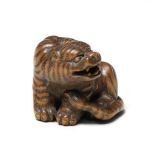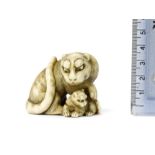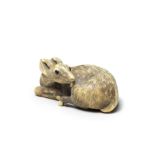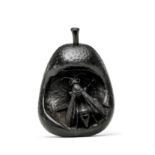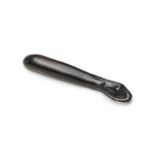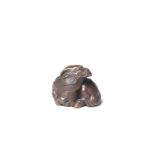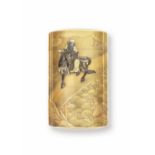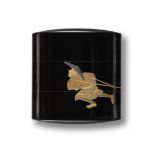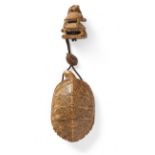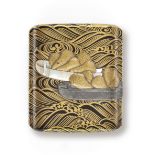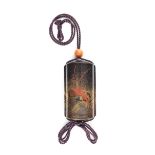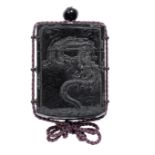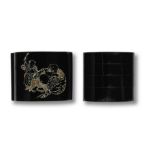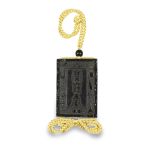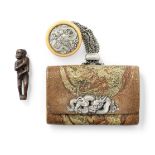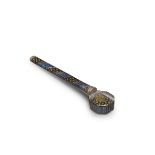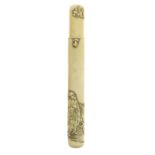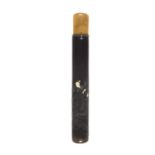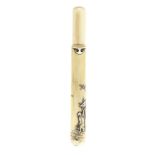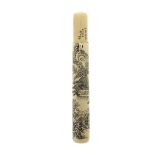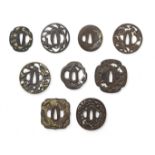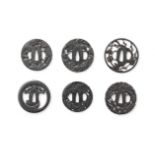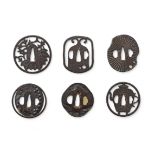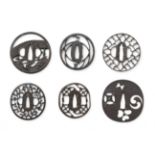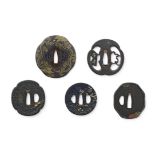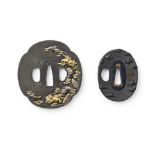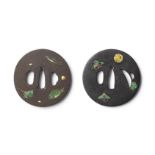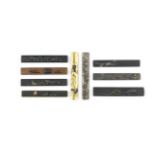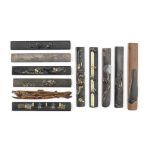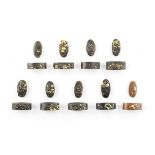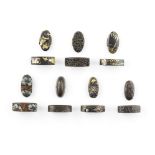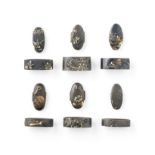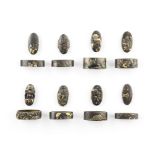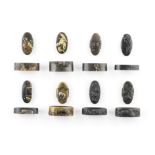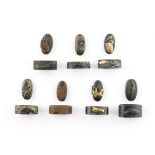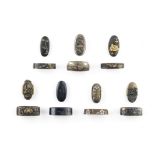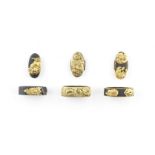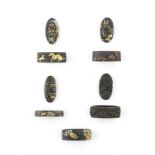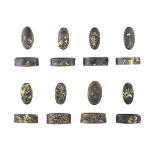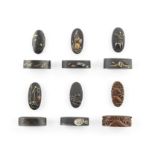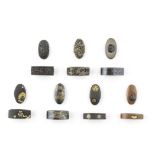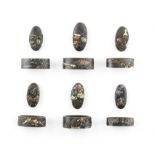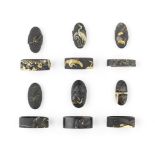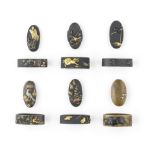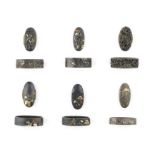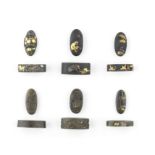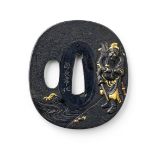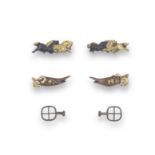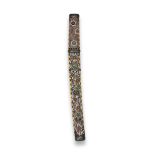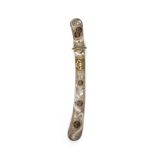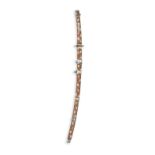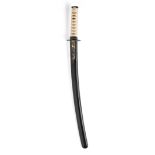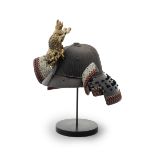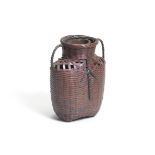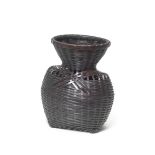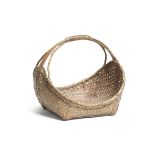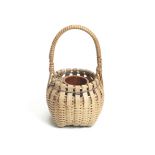- Liste
- Galerie
-
374 Los(e)/Seite
Ein Abonnement der Preisliste ist notwendig um Ergebnisse, von Auktionen die vor einem längeren Zeitraum als 10 Tagen stattgefunden haben, ansehen zu können. Klicken Sie hier für mehr Informationen
A wood netsuke of a tiger By Masanao, Yamada, Ise Province, Edo period (1615-1868), 19th century
A wood netsuke of a tigerBy Masanao, Yamada, Ise Province, Edo period (1615-1868), 19th centuryThe tiger seated, turning to its left, snarling wit...
An ivory netsuke of a tigress and cubSchool of Tomotada, Kyoto, late 18th centuryThe mother seated, her head turned to the right, her tail passing...
An ivory netsuke of a recumbent deer By Garaku, Osaka, Edo period (1615-1868), early 19th century
An ivory netsuke of a recumbent deerBy Garaku, Osaka, Edo period (1615-1868), early 19th centurySeated, its legs drawn into a compact composition,...
An ebony netsuke of a wasp in a rotting pear By Sangetsu, Edo period (1615-1868), mid 19th century
An ebony netsuke of a wasp in a rotting pearBy Sangetsu, Edo period (1615-1868), mid 19th centuryThe pear of typical form, carved all over with uk...
A kurogaki (black persimmon) wood sashi netsuke of an aubergine Attributed to Kaigyokusai Masatsu...
A kurogaki (black persimmon) wood sashi netsuke of an aubergineAttributed to Kaigyokusai Masatsugu, Osaka, Meiji era (1868-1912), circa 1870The au...
A fine wood netsuke of a recumbent kirinBy Ikkan (1817-1893), Nagoya, 19th centuryLying with its head slightly raised and turned to the left, its ...
A metal-inlaid gold-lacquer four-case inro By a member of the Kajikawa Family, Edo period (1615-1...
A metal-inlaid gold-lacquer four-case inroBy a member of the Kajikawa Family, Edo period (1615-1868), circa 1800The gold-lacquer ground decorated ...
A roiro (black-lacquer) two-case inro By Tatsuke Takamitsu (Kokyo, active 1818-1830), Edo period ...
A roiro (black-lacquer) two-case inroBy Tatsuke Takamitsu (Kokyo, active 1818-1830), Edo period (1615-1868), early/mid 19th centuryThe black-lacqu...
A lacquer single-case inroBy Ryusei, Edo period (1615-1868), 19th centuryThe rich gyobu ground decorated in polychrome takamaki-e, depicting a sna...
A boxwood three-case inro, ojime and netsuke in the form of terrapins By Gekko, Edo period (1615-...
A boxwood three-case inro, ojime and netsuke in the form of terrapinsBy Gekko, Edo period (1615-1868), mid 19th centuryEach naturalistically carve...
An inlaid black-and-gold-lacquer two-case inro By Koma Kansai, after a design by Hon'ami Koetsu (...
An inlaid black-and-gold-lacquer two-case inroBy Koma Kansai, after a design by Hon'ami Koetsu (1558-1637), Edo period (1615-1868), 19th centuryTh...
A roiro (black-lacquer) five-case inroEdo period (1615-1868), circa 1800The rich black-lacquer ground decorated with togidashi maki-e, depicting a...
A metal-inlaid gold-lacquer four-case inroBy Shokyosai, Edo period (1615-1868), circa 1850Of oval form, each side with a foliate reserve, decorate...
A large black-lacquer wood single-case inro Style of Shibata Zeshin, Meiji era (1868-1912), late ...
A large black-lacquer wood single-case inroStyle of Shibata Zeshin, Meiji era (1868-1912), late 19th centuryIn the form of a partly used ink-cake,...
A roiro (black-lacquer) saya (sheath) inro By Kajikawa Shoshin (Akinobu), after a design by Kano ...
A roiro (black-lacquer) saya (sheath) inroBy Kajikawa Shoshin (Akinobu), after a design by Kano Naonobu (1607-1650), Edo period (1615-1868) or Mei...
A black-lacquer two-case inro By Shibata Zeshin (1807-1891), Meiji era (1868-1912), late 19th cen...
A black-lacquer two-case inroBy Shibata Zeshin (1807-1891), Meiji era (1868-1912), late 19th centuryOf rectangular Chinese ink-cake form decorated...
A tabako-ire (tobacco pouch) with kagamibuta netsuke and a wood netsuke The netsuke attributed to...
A tabako-ire (tobacco pouch) with kagamibuta netsuke and a wood netsukeThe netsuke attributed to Tanaka Minko, both Edo period (1615-1868), early/...
A shell-inlaid yatate (portable brush and ink container) Somada style, Meiji era (1868-1912), lat...
A shell-inlaid yatate (portable brush and ink container)Somada style, Meiji era (1868-1912), late 19th/early 20th centuryEntirely inlaid with irid...
An ivory kiseruzutsu (pipe case) By Joho, Edo period (1615-1868) or Meiji era (1868-1912), 19th c...
An ivory kiseruzutsu (pipe case)By Joho, Edo period (1615-1868) or Meiji era (1868-1912), 19th centuryOf muso-zutsu form, carved in relief with T...
A lacquered-horn kiseruzutsu (pipe case)By Tomin, Meiji era (1868-1912), late 19th centuryOf muso-zutsu form with ivory top, the main section blac...
An ivory kiseruzutsu (pipe case)By Kyomin, Tokyo, Meiji era (1868-1912), late 19th centuryOf muso-zutsu form, carved in relief with a sennin emerg...
An ivory kiseruzutsu (pipe case)By Tesseki, Taisho era (1912-1926), dated 1913Of muso-zutsu form, finely engraved in kebori with a continuous scen...
Nine tsuba (sword guards)Edo period (1615-1868), 18th to 19th centuryThe first of shakudo, lobed mokkogata outline, chiselled with chrysanthemums ...
Six Echizen tsuba (sword guards)Edo period (1615-1868), 17th to 19th centuryAll of iron, circular or roughly circular, and made in Echizen Provinc...
Six tsuba (sword guards)Edo period (1615-1868), 17th to 19th centuryAll of iron, the first circular, pierced and chiselled with a paulownia crest,...
Six tsuba (sword guards) Momoyama (1573-1615) to Edo (1615-1868) period, late 16th to 19th centur...
Six tsuba (sword guards)Momoyama (1573-1615) to Edo (1615-1868) period, late 16th to 19th centuryAll of iron and roughly circular except for the f...
Five tsuba (sword guards)Edo period (1615-1868), 18th to 19th centuryThe first of shibuichi, lobed mokkogata outline, with flush gold inlay of sty...
Two tsuba (sword guards)Edo period (1615-1868), 19th centuryThe first of shibuichi nanako, lobed mokkogata outline, inlaid in gold and silver with...
Two iron and cloisonné-enamel tsuba (sword guards)Edo period (1615-1868), 19th centuryBoth iron, circular, the first with bold nanako-style granul...
Nine kozuka (knife handles)Edo period (1615-1868), 18th to 19th centuryOf shakudo, shibuichi, copper, or brass, decorated in a variety of chiselli...
Eleven kozuka (knife handles)Edo period (1615-1868), 17th to 19th centuryOf shakudo, shibuichi, copper, or iron, decorated in a variety of chisell...
Nine fuchi-gashira (hilt collars and pommels) Edo period (1615-1868), 18th to 19th century (18)
Nine fuchi-gashira (hilt collars and pommels)Edo period (1615-1868), 18th to 19th centurySeven of shibuichi, one of shakudo, and one of copper, de...
Seven fuchi-gashira (hilt collars and pommels) Edo period (1615-1868), 18th to 19th century (14)
Seven fuchi-gashira (hilt collars and pommels)Edo period (1615-1868), 18th to 19th centuryFour of shibuichi, two of shakudo, and one of copper, de...
Six fuchi-gashira (hilt collars and pommels) Edo period (1615-1868), 18th to 19th century (12)
Six fuchi-gashira (hilt collars and pommels)Edo period (1615-1868), 18th to 19th centuryThree of shibuichi, two of shakudo, and one of iron, decor...
Eight fuchi-gashira (hilt collars and pommels) Edo period (1615-1868), 18th to 19th century (16)
Eight fuchi-gashira (hilt collars and pommels)Edo period (1615-1868), 18th to 19th centuryAll of shibuichi, decorated in a variety of chiselling a...
Eight fuchi-gashira (hilt collars and pommels) Edo period (1615-1868), 18th to 19th century (16)
Eight fuchi-gashira (hilt collars and pommels)Edo period (1615-1868), 18th to 19th centuryFour of shibuichi, three of shakudo, and one of brass, d...
Seven fuchi-gashira (hilt collars and pommels) Edo period (1615-1868), 18th to 19th century (14)
Seven fuchi-gashira (hilt collars and pommels)Edo period (1615-1868), 18th to 19th centuryFour of shakudo, two of shibuichi, and one of copper, de...
Seven fuchi-gashira (hilt collars and pommels) Edo period (1615-1868), 18th to 19th century (14)
Seven fuchi-gashira (hilt collars and pommels)Edo period (1615-1868), 18th to 19th centuryTwo of shibuichi, three of shakudo, and two of brass, de...
Three fuchi-gashira (hilt collars and pommels) Edo period (1615-1868), 18th to 19th century (6)
Three fuchi-gashira (hilt collars and pommels)Edo period (1615-1868), 18th to 19th centuryAll of shakudo nanako with decoration in gold relief, so...
Four fuchi-gashira (hilt collars and pommels) and a fuchi (hilt collar) Edo period (1615-1868), 1...
Four fuchi-gashira (hilt collars and pommels) and a fuchi (hilt collar)Edo period (1615-1868), 18th to 19th centuryThe fuchi-gashira of shibuichi ...
Eight fuchi-gashira (hilt collars and pommels) Edo period (1615-1868), 18th to 19th century (16)
Eight fuchi-gashira (hilt collars and pommels)Edo period (1615-1868), 18th to 19th centuryFour of shibuichi, two of shakudo, and one of copper, de...
Six fuchi-gashira (hilt collars and pommels) Edo period (1615-1868), 18th to 19th century (12)
Six fuchi-gashira (hilt collars and pommels)Edo period (1615-1868), 18th to 19th centuryThree of shakudo nanako, one of shibuichi, and one of copp...
Seven fuchi-gashira (hilt collars and pommels) Edo period (1615-1868), 18th to 19th century (14)
Seven fuchi-gashira (hilt collars and pommels)Edo period (1615-1868), 18th to 19th centuryThree of shibuichi, two of shakudo nanako, one of iron, ...
Six fuchi-gashira (hilt collars and pommels) Edo period (1615-1868), 18th to 19th century (12)
Six fuchi-gashira (hilt collars and pommels)Edo period (1615-1868), 18th to 19th centuryFour of shibuichi, one of shakudo, and one of iron, decora...
Six fuchi-gashira (hilt collars and pommels) Edo period (1615-1868), 18th to 19th century (12)
Six fuchi-gashira (hilt collars and pommels)Edo period (1615-1868), 18th to 19th centuryFour of shakudo nanako, one of shakudo migaki-ji, decorate...
Six fuchi-gashira (hilt collars and pommels) Edo period (1615-1868), 18th to 19th century (12)
Six fuchi-gashira (hilt collars and pommels)Edo period (1615-1868), 18th to 19th centuryThree of shakudo nanako, one of shibuichi, and one of bras...
Six fuchi-gashira (hilt collars and pommels) Edo period (1615-1868), 18th to 19th century (12)
Six fuchi-gashira (hilt collars and pommels)Edo period (1615-1868), 18th to 19th centuryOf shibuichi or shakudo, decorated in a variety of chisell...
Six fuchi-gashira (hilt collars and pommels) Edo period (1615-1868), 18th to 19th century (12)
Six fuchi-gashira (hilt collars and pommels)Edo period (1615-1868), 18th to 19th centuryThree of shibuichi and two of shakudo nanako, decorated in...
An Ichinomiya tsuba (sword guard)Edo period (1615-1868), 19th centuryOf rounded rectangular form, bearing an ishime ground, carved and inlaid with...
Three menuki (paired hilt ornaments)Edo period (1615-1868), 18th to 19th centuryThe first of gold and shakudo, each in the form of two galloping h...
A cloisonné-enamel koshira-e (mounting) with tanto (dagger)The cloisonné-enamel mounts: Meiji era (1868-1912), the blade: Edo period (1615-1868), ...
A cloisonné-enamel koshira-e (mounting) with naginata-naoshi wakizashi (spear reforged into ...
A cloisonné-enamel koshira-e (mounting) with naginata-naoshi wakizashi (spear reforged into a short sword)The cloisonné-enamel mounts: Meiji era (...
A cloisonné-enamel koshira-e (mounting) with tachi (slung sword)The cloisonné-enamel mounts probably by a Nagoya workshop, Meiji era (1868-1912), ...
A mounted Koto wakizashi (short sword) The blade by Kanemoto, Muromachi (1333-1573) or Momoyama (...
A mounted Koto wakizashi (short sword)The blade by Kanemoto, Muromachi (1333-1573) or Momoyama (1573-1615) period, 16th century; the mounts: Edo p...
A Shin-shinto o-tanto (long dagger) After Masamune, probably Edo period (1615-1868), 19th century
A Shin-shinto o-tanto (long dagger)After Masamune, probably Edo period (1615-1868), 19th centuryOf hira-zukuri form, gunome-ha of nie with distinc...
A sujibachi kabuto (ridged helmet)Muromachi period (1333-1573), dated 1533The 62-plate sujibachi kabuto in russet iron, the top with a four-stage ...
SUZUKI GENGENSAI (1891–1950)Taisho (1912-1926) or Showa (1926-1989) era, circa 1923–1950A hanging flower basket in Chinese style, dyed timber bamb...
SUEMURA SHOBUN (1917–2000)Showa era (1926-1989), second half of the 20th century'Abundant Catch' hanging flower basket, dyed timber bamboo; twined...
TANABE CHIKUUNSAI I (1877–1937) Taisho (1912-1826) or Showa (1926-1989) era, circa 1920-193...
TANABE CHIKUUNSAI I (1877–1937)Taisho (1912-1826) or Showa (1926-1989) era, circa 1920-1930'Twin Moons' fruit basket, timber bamboo, partially pee...
WADA WAICHISAI II (1877–1933) Taisho (1912-1926) or Showa (1926-1989) era, circa 1915–...
WADA WAICHISAI II (1877–1933)Taisho (1912-1926) or Showa (1926-1989) era, circa 1915–1930'Maple Leaves', an unusual rattan flower basket, white ra...
-
374 Los(e)/Seite


